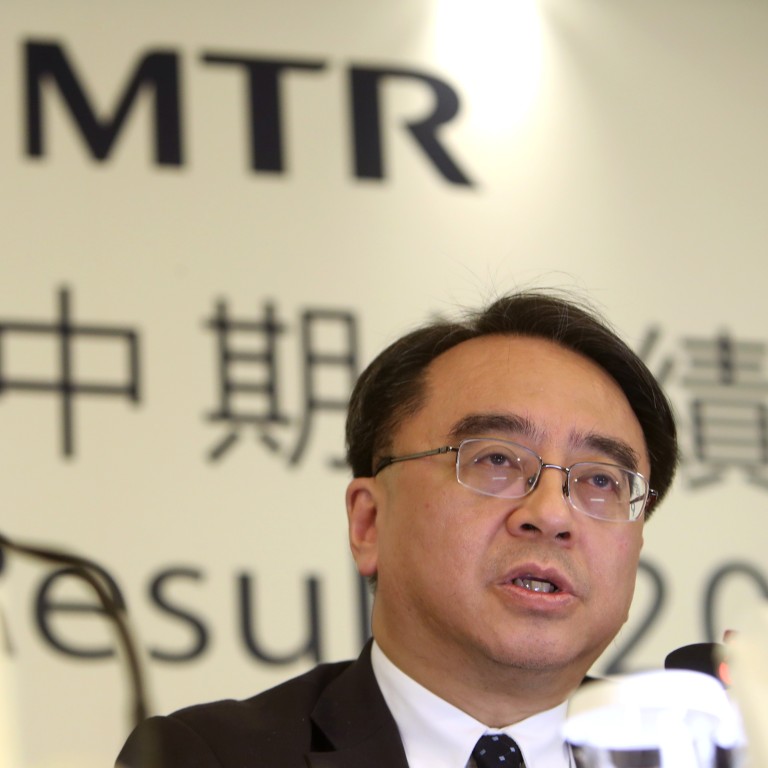
Hang Seng blue-chip MTR still divides analysts after US$9.2 billion sell-off since July
- Falling ticket and retail revenues, high repair costs and shrinking tourist spending are punishing MTR’s short-term performance as company stock and bond fall
- Hong Kong’s sole rail operator is still a good long-term bet as future property sales could offset losses from protests, says Kenny Tang of China Hong Kong Capital Asset
The slump underscores the tasks faced by chief executive officer Jacob Kam Chak-pui in restoring its operations and comforting investors about its earnings and credit outlook, after protesters vented their frustrations against the authorities by thrashing MTR assets across its network. The government controls 75 per cent of MTR.
“It has become public enemy number two, after the police,” said Francis Lun, chief executive officer at Geo Securities in Hong Kong, who has maintained his ‘sell’ calls since July. “The demonstrators have so much hatred for MTR that they will try to destroy equipment whenever they have a chance.”

The strife marks the deepest political crisis for the local government since the British handover in 1997, while a key election looms next month. It also comes as the city’s economy is on track to enter a technical recession in the three months ending December.
MTR has refuted those accusations, saying the force was stretched across Hong Kong Island to deal with the protests.
Some investors are worried over the fallout and appear to be shunning the stock going by one technical measure. On July 18, the stock’s 14-day relative strength index was at 82, compared with 44 at present. A reading above 70 indicates a stock is overbought, while a level below 30 is deemed oversold.
Analysts are also split on their calls, according to data compiled by Bloomberg; five recommend a ‘buy’, four have a ‘hold’ while two rate the stock a ‘sell.’
“The key overhang on the stock is how long the protests last,” said Jeff Yau Cheuk-man, research director at DBS Vickers Securities. “Going into [the fourth-quarter], protests are key to its business. Even if protests stop, investors may pick more high-growth stocks, not defensive play.”
MTR has estimated the repair costs at about HK$40 million to replace 1,200 turnstiles, 800 ticket and Octopus top-up machines, and 900 closed-circuit cameras that had been vandalised by protesters. Far worrisome, though, is the hit on fare revenues and retail spending in malls owned by the corporation, as tourist arrivals have slid, analysts said.
Are the MTR’s early closures necessary for repairs or a ‘de facto curfew’?
MTR has long been cherished as one of Hong Kong’s safest bets. Since its debut in 2000, the stock has rewarded investors with a 369 per cent gain, compared with a 68 per cent advance in the Hang Seng Index. That is 8.4 per cent return on annualised basis, versus the index’s 2.8 per cent.
The stock could rebound on the prospects of income from future property developments, according to Kenny Tang Sing-hing, chief executive of China Hong Kong Capital Asset. The group has a steady amount of property sales for the next two to three years, making it a buy for medium to long term, he said.
Its mall in Lohas Park MTR station is to be completed in the second half of 2020, while those in Tai Wai and Wong Chuk Hang are due to be finished in 2023. These malls will add 49 per cent to MTR’s total retail floor space, according to analysts at Bloomberg Intelligence in an October 10 report.

“Continued unrest in Hong Kong isn’t likely to undermine MTR’s long-term earnings fundamentals as demand for its train services, retail space and home projects may stay resilient even as retail spending and property investment slows down,” they wrote. “The transport segment may slip temporarily into loss but income from property may continue to underpin profits.”
Still, it may get worse before it gets better for MTR in the short term. Even before the current crisis unfolded, profits have slumped in the first six months this year. MTR’s 2047 US dollar-denominated bonds have also dropped, as credit rating companies turned cautious on its creditworthiness.
Moody’s Investor Service cut its rating outlook to negative from stable on September 17. On October 11, it said the ongoing protests were ‘credit negative’ for the rail operator, citing concerns about falling ridership.
MTR management failings see it take a 26 per cent beating
Fitch Ratings downgraded MTR on September 10 by one step to ‘AA’ with a negative outlook. S&P Global Rating also said last month that MTR’s stand-alone credit profile may weaken if protests continue to hurt ridership and retail sentiment.
Foreign visitors account for about 11 per cent of MTR’s fare revenue, according to Yau of DBS Vickers. Even when protests subside, it doesn’t mean tourists will come back immediately, he said.
Lun of Geo Securities said MTR can’t operate in its current form given the lingering protests. “The government [should] buy out minority shareholders and then make it into a transport department, and ask police to guard the facilities. It cannot operate in its current form. The best solution is for MTR to be privatised.”
Additional reporting by Yujing Liu and Shidong Zhang

